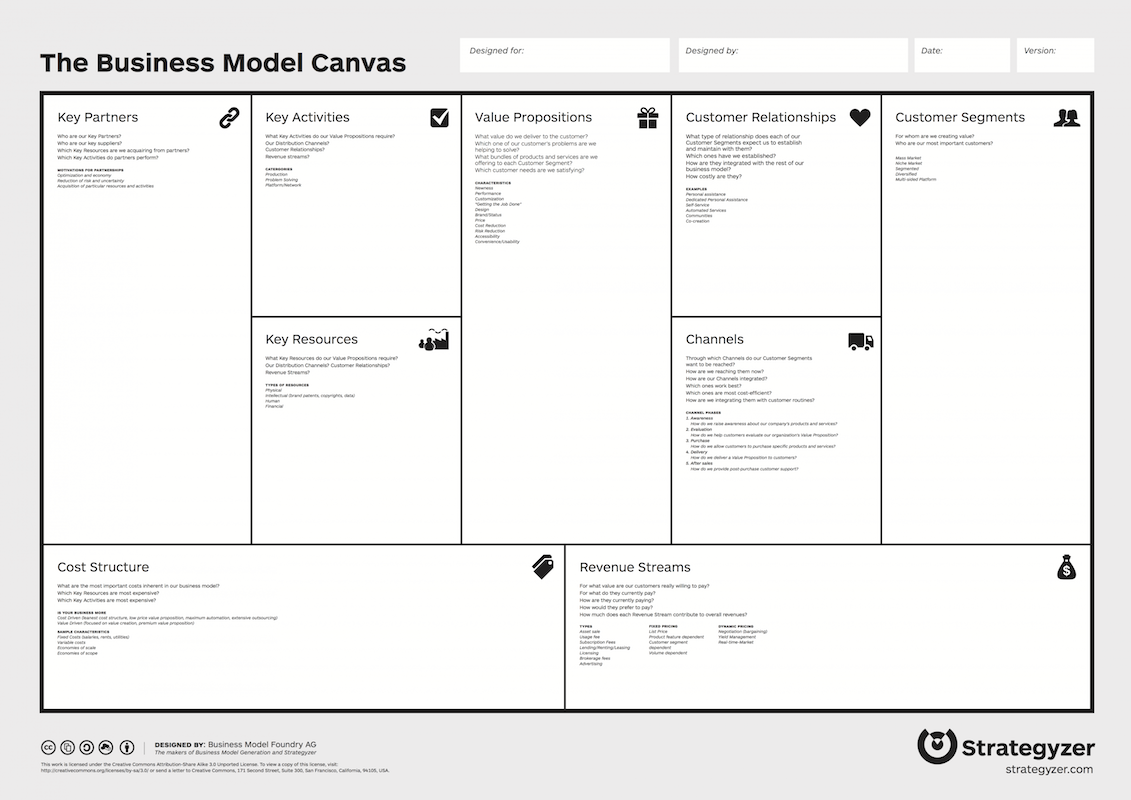With the wave of the Lean Startup Method, the business model canvas has become a regular in our startup vocabulary. You’ve maybe even tossed the term around yourself, but what does it actually mean and how do you actually implement it?
- Social Business Model Canvas
- The business model canvas allows you to frame a hypotheses which you then test with customers until you get to the point in the validation process where you have enough to go on to build a minimum viable product. In simple terms, a good and conclusive canvas lays the groundwork for your business and changes with every iteration you go through. It describes how you create, deliver and capture value.
Originally crowdsourced, the book “Business Model Generation” by Alexander Osterwalder and Yves Pigneur at Strategyzer has sold over one million copies in 30 languages. The canvas allows you to frame a hypotheses which you then test with customers until you get to the point in the validation process where you have enough to go on to build a minimum viable product. In simple terms, a good and conclusive canvas lays the groundwork for your business and changes with every iteration you go through. It describes how you create, deliver and capture value.
The aim of this article is not to reinvent the wheel or summarize the extensive literature on the topic. It is a guide covering the basics and hopefully sparking your interest with lots of extra reading to dive into the deep end of the business model canvas pool for social entrepreneurs.
The Why and the How
Now I realize the term ‘business model’ has a corporate ring to it - not a language that the social sector historically has been friendly with, let alone fond of. But if you think about it, creating, delivering and capturing value is precisely what social entrepreneurs do. Let’s face it, a business model - the engine for sustained earned revenue - is what any social entrepreneur needs if (s)he doesn’t want to be stuck in the endless cycle of writing grant proposals and worrying about next month’s payroll. Besides, approaching your social enterprise through the lens of a business-model seeker will put your venture on an entrepreneurial path of seeking beneficiary-centered solutions, validated by their willingness to pay for the product or service you provide.
The business model canvas is a business’ blueprint once you strip away all the fine-tuned details and impossible-to-make business predictions found in a traditional business plan. It sketches out what you are trying to do for whom and how you think it’s going to work. The original canvas is made up of nine blocks that easy to grasp..
 Image via Stategyzer
Image via Stategyzer
The Business Model Canvas in 3 (Big) Steps
Creating Value
Start with customer segments specifying who your customer is and what his/her specific characteristics and circumstances are. What can you find out about their socio-economic situation? Their income? Their preferences, needs, behaviors, attitudes? You may be serving different segments of one population. Start with one.
As a social entrepreneur, you may have to segment customers from beneficiaries. The ones paying for your product or service are not always the ones using it exclusively (think Ruby Cup’s one-for-one model). Consider both customer segments and develop personas for each.
The value proposition is the key to your business. Is the value you are creating - providing education to underserved communities or improving healthcare access - something that your beneficiaries appreciate as much as you think? The value proposition explains what problem you are solving for your beneficiaries and how. Figuring out whether or not your product or service meets customer needs may be my favorite part of the whole canvas exercise. If forces you to develop an in-depth understanding of customers needs, desires, and their reasons for not being able to overcome the issue themselves. The product or service you develop should address these factors to ensure you are meeting a real need under your beneficiaries’ limited condition. Use the Value Proposition Canvas to drill down on the specific details of what problem your customer is facing and how exactly you are addressing it. Getting this part right is crucial.
A social enterprise’s value proposition includes the value created for both the individual and society at large - the enterprise’s social impact. If your customers and beneficiaries are not identical, ensure it specifies how you create value for both.
Channels describe how you are going to deliver that value to your customers. Will you have your own storefront, partner with existing stores, or sell your goods and services online?
Depending on the beneficiaries you are trying to reach, you may have to get creative in reaching them. Identify channels that are easy - or at least possible - for them to access. Consider whether they are literate, use mobile technology, have reliable access to electricity or public transport. Access limitations are easily overlooked so consider these from the start.
Customer relationships outline how you interact with your customers. Are you offering personal assistance or will they be able to get their hands on your product through self-service? Will you offer service through community relations or will customers go through an automated system?
Trust and respect are key when working with underserved communities. Relationships with your customers should reflect this in every aspect of communications.
Delivering Value
Key resources are a breakdown of what inputs you will need to deliver your product or service. If you make a product, your key resources may include costly machinery and manufacturing facilities. If you are in the service industry, your key resources may be technology or some specific intellectual property. Think of them in terms of physical, human, intellectual, financial.
Speaking of activities: What is your main job to run this business successfully? Are you developing a technological solution? Are you selling fair-trade goods, training ex-convicts in job skills? These are your key activities. Make sure they all drive your intended social impact. It is easy to be overwhelmed with all the opportunities you can potentially pursue to make the world a better a place. Stick to your guns and focus on your KEY activities. For now. If you are successful with your first set, you can always expand. One step at a time.
Often, especially in the social sector, you rely on partners to make your solution work. Key partnerships highlight the relationships that are crucial to your business’ success.
As a social entrepreneur you pursue at least a double- if not triple-bottom line. This means you are - by definition - accountable to a wider spectrum of stakeholders. The best way to nurture and manage these relationships is by building partnerships with key stakeholders in sectors relevant to your venture. Who else is trying to solve the issue you are working on? Who are your allies? Especially if you work in emerging economies it is crucial to forge trust and strong relationships with partners in your value chain.
Capturing Value
How are you going to pay for all this? Revenue streams indicate how you make money. Ideally, you are selling your product to generate revenue. If that’s not an option, can you sell one version to customers who can afford it in order to subsidize sales to less affluent customers? Your revenue streams may be based on the direct sale of your product or service, a subscription fee, or renting, lending or leasing. Be creative. This also brings us back to customer segments and value proposition.
Every social entrepreneur I’ve worked with has heard this piece of advice early on: Don’t give your product away for free. Don’t make your beneficiaries dependent on free handouts, give them the dignity to pay for what you offer, even if it is a very small amount. We all appreciate the things we pay for more than for the ones we get for free. Charge SOMETHING for your product or service, and find other ways to generate revenue to at least break even. Is there a secondary customer base for your product or service? Can you partner with third parties to bring your product to market (development agencies, insurance companies)? Generating multiple revenue streams makes you less dependent and more resilient in case one stream dries up.
In order to define your price points for revenue streams, you need to have a very clear idea of your cost structure. Cheap airlines operate on a low-cost structure while your social business - hopefully - runs on a value-driven one, which may include high quality (think Cartier) and high ethical value. Ideally you manage to combine elements of both. Don’t sacrifice quality to save on cost. Think of your cost structure in terms of fix versus variable costs, and whether you capitalize on economies of scale (cost per unit decreases with more units produced) or scope (can you produce similar products or services while banking on shared machines, packaging, etc.?).
Depending on how you’re structured and what partnerships you have in place, consider whether you can outsource any costs to partners, and which elements you may be able to receive at a discount or through philanthropic giving. Which types of market capital do you have access to?
Wrap-up
There are many (many!) variations on the business model canvas, specifically for social entrepreneurs and mission-driven businesses. I have used the Social Lean Canvas for teaching before, and I recently came across the Mission Model Canvas by Alexander Osterwalder. These are great resources and I highly recommend playing around with them to see which language works best for you. At the end of the day, you should be able to fill in any version of the canvas and arrive at the same conclusions.
The business model canvas is a great tool to help you sketch out your social enterprise idea. It evolves along with every round of testing and iteration your idea goes through - make sure to keep it up to date (post-its go along way!).
With that said, remember that it’s also only that. A tool. It does not focus on analyzing your competition, nor does it guide you in terms of marketing and communicating your product or service - all of which inform your strategy. The canvas captures the key factors of your potential business; it’s up to you to complement elements that are crucial to YOUR business’ success.
Further Reading
If you’re intrigued and want to learn more about the business model canvas, I recommend the following:
- Osterwalder, Alexander and Pigneur, Yves (2010). Business Model Generation.
- Osterwalder, Alexander; Pigneur, Yves; Bernarda, Greg and Smith, Allen (2014). Value Proposition Design.
Specific to Social Entrepreneurs
- Acumen. Business Models for Social Enterprise (MOOC).
- Osterwalder, Alexander (2016). This Mission Model Canvas: An Adapted Business Model Canvas for Mission-Driven Organizations (Strategyzer Blog).
- Social Lean Canvas (Website featuring the social business model canvas in different languages and examples of existing social enterprises)
- Young Foundation. The Social Business Model Canvas
- Social Entrepreneurs Resource Hub at Stanford: Social Business Model Canvas (download here).
- Dohrman, Susanne; Raith, Matthias; Siebold, Nicole (2015). Monetizing Social Value Creation: A Business Model Approach. Entrepreneurship Research Journal.
About the Author

Anika Horn has devoted her career to working social entrepreneurs from around the world building mission-driven businesses. As a mentor and coach at Social Ventures Australia, Social Impact Lab Hamburg and the DO School, Anika recently moved to the United States where she builds ecosystems for social entrepreneurs in mid-tier cities. On an international level, Anika researches best practices and common challenges in social enterprise support around the world. Her research is published under www.socialventurers.com.
Learn more about her work: www.anikahorn.com
This article was originally published in April 2016.










